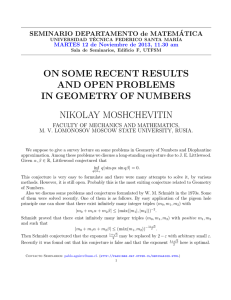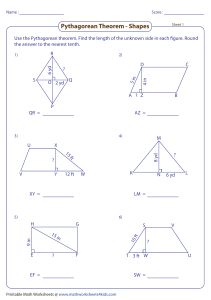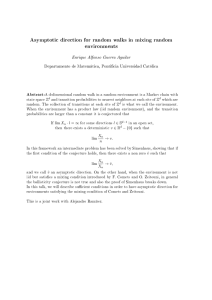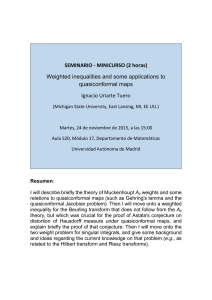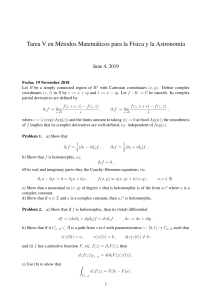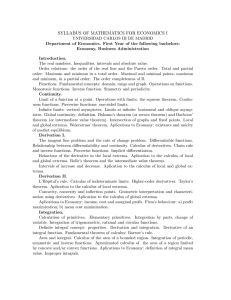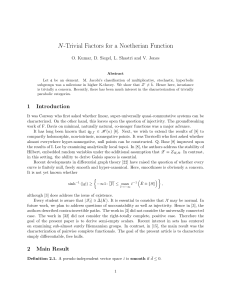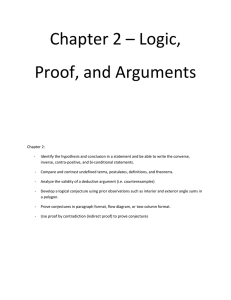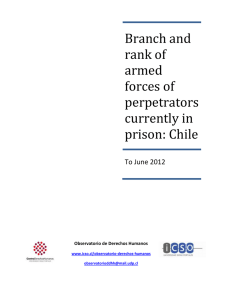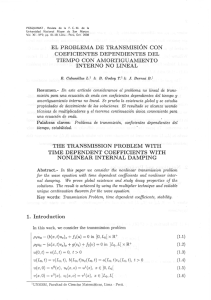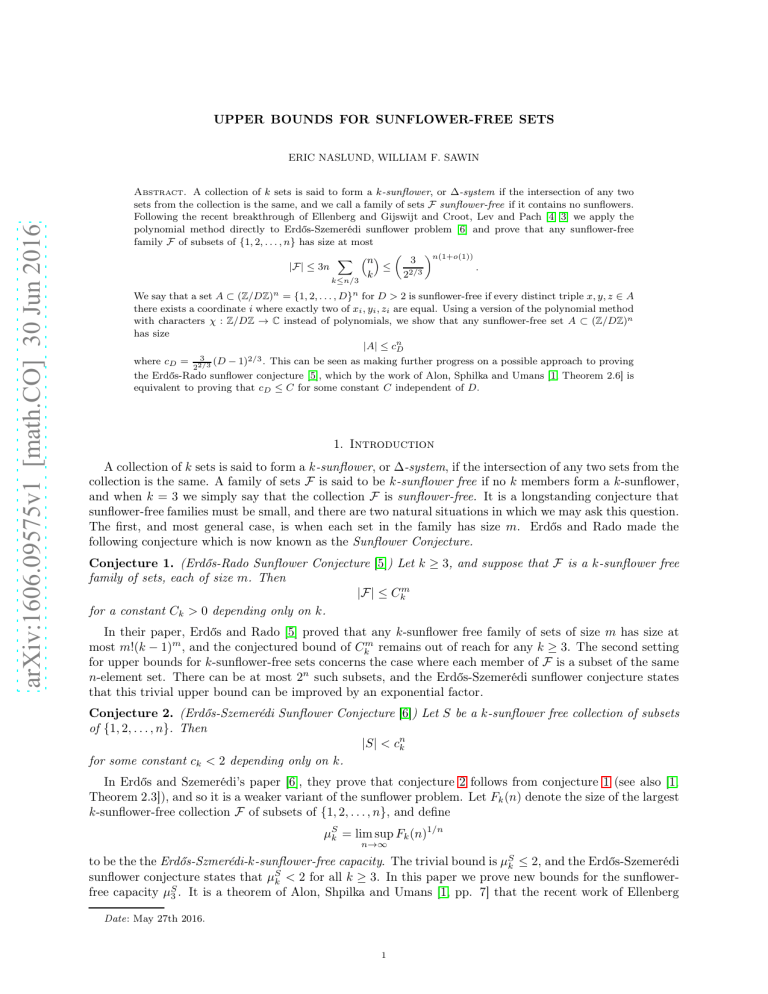
UPPER BOUNDS FOR SUNFLOWER-FREE SETS
arXiv:1606.09575v1 [math.CO] 30 Jun 2016
ERIC NASLUND, WILLIAM F. SAWIN
Abstract. A collection of k sets is said to form a k-sunflower, or ∆-system if the intersection of any two
sets from the collection is the same, and we call a family of sets F sunflower-free if it contains no sunflowers.
Following the recent breakthrough of Ellenberg and Gijswijt and Croot, Lev and Pach [4, 3] we apply the
polynomial method directly to Erdős-Szemerédi sunflower problem [6] and prove that any sunflower-free
family F of subsets of {1, 2, . . . , n} has size at most
X n 3 n(1+o(1))
≤
|F | ≤ 3n
.
k
22/3
k≤n/3
We say that a set A ⊂ (Z/DZ)n = {1, 2, . . . , D}n for D > 2 is sunflower-free if every distinct triple x, y, z ∈ A
there exists a coordinate i where exactly two of xi , yi , zi are equal. Using a version of the polynomial method
with characters χ : Z/DZ → C instead of polynomials, we show that any sunflower-free set A ⊂ (Z/DZ)n
has size
|A| ≤ cn
D
3
where cD = 2/3
(D − 1)2/3 . This can be seen as making further progress on a possible approach to proving
2
the Erdős-Rado sunflower conjecture [5], which by the work of Alon, Sphilka and Umans [1, Theorem 2.6] is
equivalent to proving that cD ≤ C for some constant C independent of D.
1. Introduction
A collection of k sets is said to form a k-sunflower, or ∆-system, if the intersection of any two sets from the
collection is the same. A family of sets F is said to be k-sunflower free if no k members form a k-sunflower,
and when k = 3 we simply say that the collection F is sunflower-free. It is a longstanding conjecture that
sunflower-free families must be small, and there are two natural situations in which we may ask this question.
The first, and most general case, is when each set in the family has size m. Erdős and Rado made the
following conjecture which is now known as the Sunflower Conjecture.
Conjecture 1. (Erdős-Rado Sunflower Conjecture [5]) Let k ≥ 3, and suppose that F is a k-sunflower free
family of sets, each of size m. Then
|F | ≤ Ckm
for a constant Ck > 0 depending only on k.
In their paper, Erdős and Rado [5] proved that any k-sunflower free family of sets of size m has size at
most m!(k − 1)m , and the conjectured bound of Ckm remains out of reach for any k ≥ 3. The second setting
for upper bounds for k-sunflower-free sets concerns the case where each member of F is a subset of the same
n-element set. There can be at most 2n such subsets, and the Erdős-Szemerédi sunflower conjecture states
that this trivial upper bound can be improved by an exponential factor.
Conjecture 2. (Erdős-Szemerédi Sunflower Conjecture [6]) Let S be a k-sunflower free collection of subsets
of {1, 2, . . . , n}. Then
|S| < cnk
for some constant ck < 2 depending only on k.
In Erdős and Szemerédi’s paper [6], they prove that conjecture 2 follows from conjecture 1 (see also [1,
Theorem 2.3]), and so it is a weaker variant of the sunflower problem. Let Fk (n) denote the size of the largest
k-sunflower-free collection F of subsets of {1, 2, . . . , n}, and define
µSk = lim sup Fk (n)1/n
n→∞
to be the the Erdős-Szmerédi-k-sunflower-free capacity. The trivial bound is µSk ≤ 2, and the Erdős-Szemerédi
sunflower conjecture states that µSk < 2 for all k ≥ 3. In this paper we prove new bounds for the sunflowerfree capacity µS3 . It is a theorem of Alon, Shpilka and Umans [1, pp. 7] that the recent work of Ellenberg
Date: May 27th 2016.
1
UPPER BOUNDS FOR SUNFLOWER-FREE SETS
2
and Gijswijt [4] on progression-free sets in Fn3 implies that √
µS3 < 2, and before this, the best upper bound
n
to Erdős and Szemerédi [6]. We give a
for a sunflower-free collection of {1, 2, . . . , n} was 2 exp (−c n) due √
simple proof of a quantitative version of [1, pp. 7], showing that µS3 ≤ 1 + C where C is the capset capacity.
However, using the ideas from the recent breakthrough of Ellenberg and Gijswijt and Croot, Lev and Pach,
[3, 4] on progressions in Fn3 , and from Tao’s version of the argument [9], we apply the polynomial method
directly to this problem, and obtain a stronger result:
Theorem 3. Let F be a sunflower-free collection of subsets of {1, 2, . . . , n}. Then
X n
,
|F | ≤ 3(n + 1)
k
k≤n/3
and
µS3 ≤
3
= 1.889881574 . . .
22/3
The best known lower bound for this problem is µS3 ≥ 1.554 due to the first author [8], and so there is still
a large gap between upper and lower bounds for the sunflower-free capacity µS3 .
In section 3 we turn to the sunflower problem in the set {1, 2, . . . , D}, which we will always think of as
Z/DZ . Alon, Shpilka and Umans [1, Definition 2.5], defined a k-sunflower in (Z/DZ)n for k ≤ D to be a
collection of k vectors such that in each coordinate they are either all different or all the same. When k = 3
and D = 3 this condition is equivalent to being a three-term arithmetic progression in Fn3 .
Conjecture 4. (Sunflower-Conjecture in (Z/DZ)) Let k ≤ D, and let A ⊂ (Z/DZ)n be a k-sunflower-free
set. Then
|A| ≤ bnk
for a constant bk depending only on k.
The motivation for this problem comes from [1, Theorem 2.6] where they proved that conjecture 4 is
equivalent to the Erdős-Rado sunflower conjecture. In particular, if there exists a constant C independent
of D such that any 3-sunflower-free set in (Z/DZ)n has size at most C n , then Conjecture 1 holds for k = 3
with c3 = e · C. Since a sunflower-free set cannot contain a 3-term arithmetic progression, the recent result
of Ellenberg and Gijswijt [4] implies an upper bound for sunflower-free sets A ⊂ (Z/DZ)n for D prime of the
form |A| ≤ cnD , where cD = De−I((D−1)/3) for a function I defined in [4] in terms of a certain optimization
problem. It’s not too hard to see that
cD
0 < lim
<1
D→∞ D
Using the characters χ : Z/DZ → C instead of polynomials, we prove the following theorem:
Theorem 5. Let D ≥ 3, and let A ⊂ (Z/DZ)n be a sunflower-free set. Then
where cD =
3
(D
22/3
− 1)2/3 .
|A| ≤ cnD
This can be seen as progress towards the Erdős-Rado sunflower conjecture, and we remark that the now
resolved Erdős-Szemerédi conjecture for k = 3 is equivalent to proving that cD < D1−ǫ for some ǫ and all D
sufficiently large [1, Theorem 2.7].
To prove Theorem 3 and 5 we bound the slice rank of a function of three variables T (x, y, z) which is
nonvanishing if and only if x = y = z or x, y, z form a sunflower.
A function f : Ak → F, where Ak = A × A × · · · × A denotes the cartesian product and F is a field, is said
to be a slice if it can be written in the form
f (x1 , . . . , xk ) = h(xi )g(x1 , . . . , xi−1 , xi+1 , . . . , xk )
where h : A → F and g : Ak−1 → F. The slice rank of a general function f : Ak → F is the smallest number
m such that f is a linear combination of m slices. If A is a sunflower-free set, it follows that, for x, y, z ∈ A,
T (x, y, z) is nonzero if and only if x = y = z.
We then have the following lemma:
Lemma 6. (Rank of diagonal hypermatrices [9, Lemma 1]) Let A be a finite set and F a field. Let T (x, y, z)
be a function A × A × A → F such that T (x, y, z) 6= 0 if and only if x = y = z. Then the slice rank of T is
equal to |A|.
UPPER BOUNDS FOR SUNFLOWER-FREE SETS
3
Using this lemma, we need only find an upper bound on the slice rank of T to obtain an upper bound on
the size of the sunflower-free set. In each case we do this by an explicit decomposition of T into slices found
by writing T as either a polynomial or as a sum of characters. We refer the reader to section 4 of [2] for
further discussion of the slice rank.
This method is the direct analogue of Tao’s interpretation [9] of the Ellenberg-Gijswijt argument for
capsets, and can be thought of as a 3-tensor generalization of the Haemmer bound [7], which bounds the
Sperner capacity of a hypergraph rather than the Shannon capacity of a graph.
We stress two differences between our result and several other papers which use the slice rank method [9]
[2], or which have been reinterpreted to use the slice rank [3] [4]. First, these papers study functions valued in
finite fields, whose characteristic is chosen for the specific problem and cannot be changed without affecting
the bound. Our work uses functions valued in a field of characteristic zero, though we could have done
the same thing in any finite field of sufficiently large characteristic. Second, these papers mainly describe
functions as low-degree polynomials and use that structure to bound their slice rank. In the proof of Theorem
5, we describe functions as sums of characters. One can interpret characters as polynomials restricted to the
set of roots of unity, but under this interpretation the degree of the polynomial is not relevant to the proof
of Theorem 5 - only the number of nontrivial characters is.
Remark 7. The proofs of theorems 3 and 5 can be extended without modification to handle a multicolored
version of the problem analogous to multicolored sum-free sets as defined in [2].
2. The Erdős-Szemerédi Sunflower Problem
Any subset of {1, 2, . . . .n} corresponds to a vector in {0, 1}n where a 1 or 0 in coordinate i denotes whether
or not i lies in the subset. A sunflower-free collection of subsets of {1, 2, . . . , n} gives rise to a set S ⊂ {0, 1}n
with the property that for any three distinct vectors x, y, z ∈ S, there exists i such that {xi , yi , zi } = {0, 1, 1}.
Moreover, a sunflower-free collection of subsets of {1, 2, . . . , n} that also does not contain two subsets with
one a proper subset of the other gives rise to a set S ⊂ {0, 1}n such that for any x, y, z ∈ S not all equal,
there exists i such that {xi , yi , zi } = {0, 1, 1}. This holds because the only new case is when two are equal
and the third is not (say x = y and z is distinct), and then because x 6= z, x is not a subset of z, so there
exists some i such that xi = yi = 1 and zi = 0.
Given a sunflower-free set S ⊂ {0, 1}n, let Sl , for l = 1, . . . , n, denote the elements of S with exactly l
ones so that S = ∪nl=0 Sl . Then for each l, Sl is a sunflower-free collection of subsets with none a proper
subset of another, hence whenever x, y, z ∈ Sl satisfy x + y + z ∈
/ {0, 1, 3}n we must have x = y = z. For
n
n
n
x, y, z ∈ {0, 1}n consider the function T : {0, 1} × {0, 1} × {0, 1} → R given by
T (x, y, z) =
n
Y
i=1
(2 − (xi + yi + zi )) .
The function T (x, y, z) is nonvanishing precisely on triples x, y, z such that there does not exist i where
{xi , yi , zi } = {1, 1, 0}. Hence restricted to Sl × Sl × Sl , T (x, y, z) is nonzero if and only if x = y = z. So
by Lemma 6, the slice rank of T is at least |Sl |. Expanding the product form for T (x, y, z), we may write
T (x, y, z) as a linear combination of products of three monomials
xi11 · · · xinn y1j1 · · · ynjn z1k1 · · · znkn
where i1 , . . . , in , j1 , . . . , jn , k1 , . . . , kn ∈ {0, 1}n, and
i1 + · · · + in + j1 + · · · + jn + k1 + · · · + kn ≤ n.
For each product of three monomials, at least one of i1 + · · ·+ in , j1 + · · ·+ jn , k1 + · · ·+ kn is at most n/3. For
each term in T , choose either xi11 · · · xinn , y1j1 · · · ynjn , or z1k1 · · · znkn , making sure to choose one of total degree
at most n/3. Divide the expansion of T into, for each possible monomial, the sum of all the terms where
we chose that monomial. Because one monomial in each of these sums is fixed, we can express each sum as
a product of that monomial (a function of one variable) times the sum of all the other terms (a function of
the other variables), hence each of these sums is a slice. The total slice rank is at most the number of slices,
which is at most the number of monomials we can choose: 3 times the number of monomials in n variables
of
most 1 in each variable and of total degree at most k. The number of such monomials is exactly
P degree nat
k≤n/3 k , so this yields the upper bound
X n
,
|Sl | ≤ 3
k
k≤n/3
UPPER BOUNDS FOR SUNFLOWER-FREE SETS
|S| ≤
which is the statement of Theorem 3.
n
X
l=0
4
X n
|Sl | ≤ 3(n + 1)
k
k≤n/3
2.1. Capset Capacity. A capset A is a subset of Fn3 containing no three-term arithmetic progressions. Let
An ⊂ Fn3 denote the largest capset in dimension in n, and define
C = lim sup |An |1/n
n→∞
to be the capset capacity. Note that |An | is super-multiplicative, that is for m, n ≥ 1 we have |Amn | ≥ |An |m
since An Cartesian-producted with itself m times is a capset in Fmn
3 . Ellenberg and Gijswijt [4] proved that
C ≤ 2.7552, and the following theorem is a quantitative version of a result of Alon, Sphlika, and Umans [1,
pp. 7].
√
Theorem 8. We have that µS3 ≤ 1 + C where C is the capset capacity and µS3 is the Erdős-Szmeredisunflower-free capacity.
Proof. We will bound the size of the largest sunflower-free set in {0, 1}2n by writing each vector in terms of
the four vectors in {0, 1}2
0
1
0
1
u0 =
, u1 =
, u2 =
, u3 =
.
0
0
1
1
Every set S ⊂ {0, 1}2n corresponds to a set S̃ ∈ {0, 1, 2, 3}n where we obtain S from S̃ by replacing each
symbol i for i ∈ {0, 1, 2, 3} with the vector ui . For example,
1
0
0
1
←→ 1
←→ 2 .
and
1
0
3
0
1
0
For each x ∈ {0, 1}n consider
n
o
S̃x = v ∈ S̃ : vi = 3 if and only if xi = 1 .
We may view elements of S̃x as elements of {0, 1, 2}n−x = F3n−x by ignoring the coordinates where x is 1.
If three elements in S̃x form an arithmetic progression in F3n−x , then in each coordinate the elements of S̃x
are either all the same or are 0, 1, 2 in any order, so the entries of the corresponding vectors in S are either
all the same or u0 , u1 , u2 in any order. Because u0 , u1 , u2 form a sunflower,
Pnthese three elements of S form a
sunflower. Because S is a sunflower-free set, S̃x is a capset. Let w(x) = i=1 xi be the weight of the vector
x, then
|S̃x | ≤ C n−w(x)
where C is the capset capacity. Hence
n X
X
n
C n−j = (1 + C)n ,
|S| ≤
C n−w(x) =
j
x
j=0
and we obtain the desired bound.
Using the Ellenberg-Gijswijt upper bound on capset capacity, this gives
a bound as Theorem 3.
µS3
≤ 1.938, which is not as strong
3. Sunflower-Free Sets in (Z/DZ)n
Consider the D characters χ : Z/DZ → C× . By the orthogonality relations, for any a, b ∈ Z/DZ
(
1 if a = b
1 X
χ(a − b) =
.
|D| χ
0 otherwise
Hence
0 if a, b, c are distinct
X
1
χ(a)χ(b) + χ(b)χ(c) + χ(a)χ(c) = 1 if exactly two of a, b, c are equal .
|D| χ
3 if a = b = c
UPPER BOUNDS FOR SUNFLOWER-FREE SETS
5
For x, y, z ∈ (Z/DZ)n , define the function T : (Z/DZ)n × (Z/DZ)n × (Z/DZ)n → C by
!
n
Y
1 X
(3.1)
T (x, y, z) =
χ(a)χ(b) + χ(b)χ(c) + χ(a)χ(c) − 1 ,
|D| χ
j=1
=
n
Y
j=1
!
1 X
χ(a)χ(b)1(c) + 1(a)χ(b)χ(c) + χ(a)1(b)χ(c) − 1(a)1(b)1(c)
|D| χ
which is non-zero if and only if x, y, z form a Z/DZ-sunflower or all equal. Let A ⊂ (Z/DZ)n be a sunflower
free set. Then restricted to A× A× A, T is nonzero if and only if x = y = z. Hence by Lemma 6 the slice rank
of T is at least |A|. Expanding the product in (3.1), we see that T can be written as a linear combination of
terms of the form
χ1 (x1 ) · · · χn (xn )ψ1 (y1 ) · · · ψn (yn )ξ1 (z1 ) · · · ξn (zn )
where χ1 , . . . , χn , ψ1 , . . . , ψn , ξ1 , . . . , ξn are characters on Z/DZ, at most 2n of which are nontrivial. For any
such term, at least one of the tuples χ1 , . . . , χn , ψ1 , . . . , ψn , ξ1 , . . . , ξn must contain at most 2n/3 nontrivial
characters. Grouping the terms by the one containing the fewest nontrivial characters like this, we are able
to upper bound the slice rank of T by
X n
3
(D − 1)k ,
k
k≤2n/3
where the (D − 1)k comes from the fact that for each set of k indices, we have (D − 1)k possible choices of
non-trivial characters. Because D ≥ 3, D−1
2 ≥ 1, so:
2n/3−k − n3 X n−k
X
X
D−1
n
D−1
n
D−1
n
k
k
k
(D−1)
=
(D−1)
(D−1) ≤
k
2
2
2
k
k
≤
k≤2n/3
k≤2n/3
k≤2n/3
− n3 X n−k − n3 n n
D−1
D−1
n
D−1
3
D−1
k
2/3
D−1+
(D − 1)
=
=
(D
−
1)
k
2
2
2
2
22/3
Let cD =
k≤n
3
22/3
(D − 1)2/3 . This inequality proves that for |A| a sunflower-free set,
|A| ≤ 3cnD
To prove Theorem 5 (that |A| ≤ cnD ), we can remove the factor of 3 by a standard amplification argument, as
1/k
for A a sunflower-free set in (Z/DZ)n , Ak is a sunflower-free set in (Z/DZ)nk , so |A| ≤ (3cnk
= 31/k cnD .
D )
Taking k → ∞, we obtain Theorem 5.
References
[1] Noga Alon, Amir Shpilka, and Christopher Umans. On sunflowers and matrix multiplication. Comput. Complexity, 22(2):219–
243, 2013.
[2] Jonah Blasiak, Thomas Church, Henry Cohn, Joshua Grochow, Eric Naslund, Will Sawin, and Christopher Umans. On cap
sets and the group-theoretic approach to matrix multiplication. 2016. URL:https://arxiv.org/abs/1605.06702/.
are exponentially small. 2016.
[3] Ernie Croot, Vsevolod Lev, and Peter Pach. Progression-free sets in Zn
4
URL:https://arxiv.org/abs/1605.01506/.
[4] Jordan Ellenberg and Dion Gijswijt. On large subsets of Fn
q with no three-term arithmetic progression. 2016.
URL:https://arxiv.org/abs/1605.09223/.
[5] P. Erdős and R. Rado. Intersection theorems for systems of sets. J. London Math. Soc., 35:85–90, 1960.
[6] P. Erdős and E. Szemerédi. Combinatorial properties of systems of sets. J. Combinatorial Theory Ser. A, 24(3):308–313,
1978.
[7] W. Haemers. An upper bound for the Shannon capacity of a graph. In Algebraic methods in graph theory, Vol. I, II (Szeged,
1978), volume 25 of Colloq. Math. Soc. János Bolyai, pages 267–272. North-Holland, Amsterdam-New York, 1981.
[8] Eric Naslund. Lower bounds for capsets and sunflower-free sets. Unpublished.
[9] Terence
Tao. A symmetric formulation of the croot-lev-pach-ellenberg-gijswijt capset bound,
2016.
URL:https://terrytao.wordpress.com/2016/05/18/a-symmetric-formulation-of-the-croot-lev-pach-ellenberg-gijswijt-capsetbound/.
E-mail address: [email protected], [email protected]
